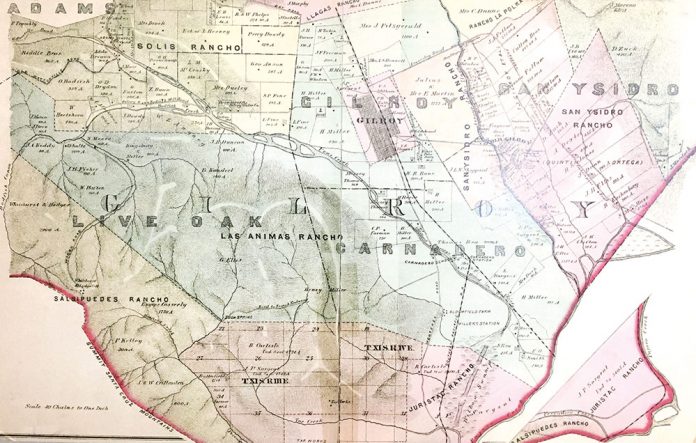
Nine years after Gilroy was incorporated as a city, most of its landowners didn’t know the exact boundaries of their properties.
But when the so-called “Cattle King” Henry Miller came into town and began purchasing property in the 26,000-acre Las Animas Rancho, where Gilroy was located, he filed what was considered a “friendly” lawsuit to clear up the title to all the lands.
As historians with the Gilroy Historical Society put it, optimists at the time thought the suit would be over in a year, maybe a little longer.
That wasn’t the case.
Henry Miller et al vs. Massey Thomas et al was filed in San Jose on Jan. 3, 1879, more commonly known as the Las Animas Partition Suit. When the suit wrapped up eight years later, more than 1,000 people had been involved, including the three plaintiffs, 800 defendants, tenants, attorneys and others. The case eventually settled land titles to 260 pieces of properties.
The issue’s beginnings stem back to shortly after the turn of the 19th century. The Las Animas Rancho, about 26,000 acres, was originally granted by the Spanish Viceroy of Mexico to Mariano Castro in about 1806.
When Mexico seceded from Spain in 1823, Castro reapplied to reconfirm his grant with the new Mexican government. He received confirmation, but died in 1828, so the land was then re-granted to his heirs in 1835.
Shortly thereafter the heirs began to sell their holdings, and about 16,000 acres of it went to a wealthy ranchero by the name of Jose Maria Sanchez.
[subhed] Dispute over ranches
When California became part of the United States in 1850, the U.S. government set up a land commission to establish land ownership of these old ranchos. In the case of the Las Animas Rancho there were many problems of clear title, primarily due to the fact that Castro and Sanchez, both patriarchs of large families, had died without a will, and the land was held in common among the heirs.
During the Spanish and Mexican periods, land grants were never formally surveyed. In the Spanish period, it was only required to give a written description of the location and amount of the land that was desired. In the Mexican period, a roughly drawn map was required along with the written description.
The Las Animas Rancho was never legally divided among the heirs of either Mariano Castro or Jose Maria Sanchez.
To clear up confusion, Miller filed the suit. The suit named Massey Thomas as the primary defendant, since he was the largest individual landholder.
Thomas arrived in Gilroy in 1852. His 500-acre dairy and orchard operation was centered on his home, which was located roughly where the Gilroy Sports Park operates today.
Because the newly-created City of Gilroy fell completely within the boundaries of the Rancho Las Animas, every landowner in Gilroy was involved.
The issue was a hot topic among the residents. The Gilroy Advocate dubbed it as the “Spanish fraud,” and at least one Gilroyan weighed in on the issue in a letter.
“A blight has hung over this fair city for years, and it will continue unless steps are taken to give security to every property owner and make all as free in the sense of ownership as the settlers of their places,” the letter stated, signed by “Citizen.”
After nearly a decade in court, the case eventually settled the land titles to 260 pieces of property, and very few of the landowners lost any significant amount of property.













